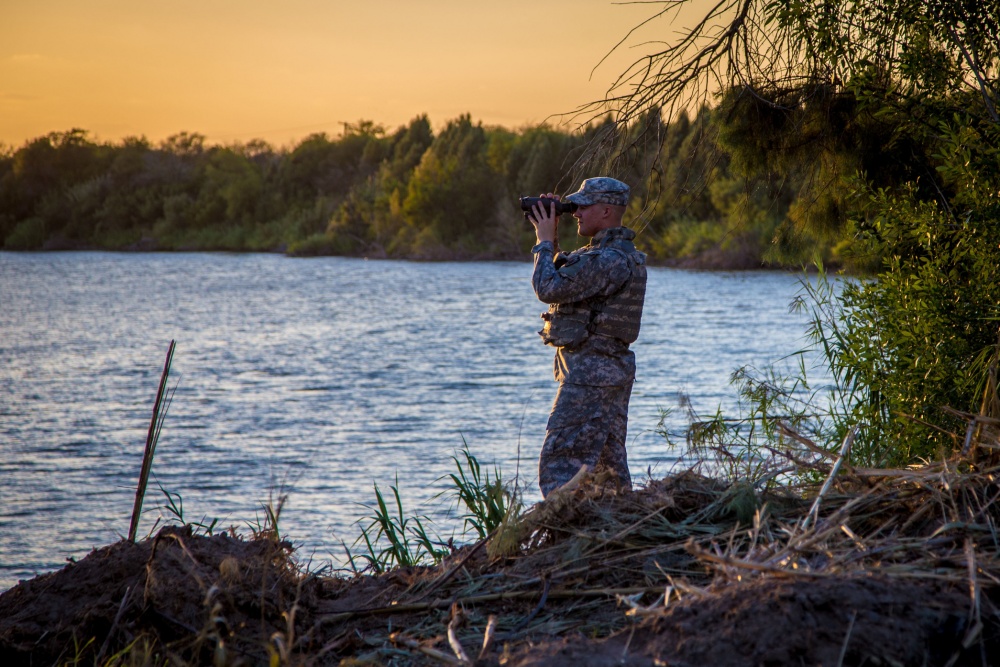 Texas Army National Guard Soldier observes a section of the Rio Grande River, along the Texas-Mexico border. The Texas Military Department's mission in support of Operation Strong Texas transitioned from an operational state active duty mission to a federal Title 32 training mission, July 2017. (U.S. Army National Guard photo by Maj. Randall Stillinger)
Texas Army National Guard Soldier observes a section of the Rio Grande River, along the Texas-Mexico border. The Texas Military Department's mission in support of Operation Strong Texas transitioned from an operational state active duty mission to a federal Title 32 training mission, July 2017. (U.S. Army National Guard photo by Maj. Randall Stillinger)
07.18.2017
Story by: Capt. Martha Nigrelle
RIO GRANDE VALLEY, Texas - Operation Secure Texas, a once State Active Duty operational mission for the Texas Guard, will transition to a federally funded Title 32 training mission, late July 2017.
The transition will allow service members to conduct hands-on training and improve unit readiness, while still providing partner agencies their unique capabilities along the Texas-Mexico border.
On July 17, 2017, Gov. Greg Abbott announced Texas will receive funding from the federal government in support of Operation Secure Texas and transition the Texas Guardsmen supporting this operation to a federal status.
“The National Guard Bureau has allocated $19 million, appropriated by the House Appropriations Subcommittee on Defense for FY17, for the four border states, California, Arizona, New Mexico and Texas, to plan, coordinate, manage and conduct additional training missions along the border to increase readiness,” said Lt. Col. Travis Walters, Texas Military Department State Public Affairs Officer. “The benefit of this transition is our ability to conduct realistic, hands-on training on many of our mission essential tasks, work alongside our partner agencies and provide an incidental benefit to the Texas Department of Public Safety’s efforts to prevent pervasive criminal elements from crossing into the U.S.”
The transition will not impact the mission of the Texas National Guard or its role in protecting and serving the citizens of Texas, said Walters. But it may improve their readiness.
The transition to a training mission will enable service members to train on more than 30 required tasks in a realistic environment, while also working in a joint environment.
“Our mission in supporting both the state and nation, whenever we are called, almost always puts us in a joint environment, working alongside partner local, state and federal agencies or partner militaries,” said Walters. “Successful synchronization of operations with partner agencies and communication across a joint network are absolutely essential skills for our Guardsmen to have whether we are responding to a hurricane here in Texas or supporting combat operations overseas.”
From the outside, the Texas Military Department’s role in supporting Operation Secure Texas really won’t change.
They will still serve under the command and control of the Governor and they will still work alongside and in support of DPS.
The unique, dual mission of the National Guard allows Guardsmen to act as a bridge between our civilian agencies and the Department of Defense.
Federal law provides the Governor with the ability to place a Soldier in a full-time duty status under the command and control of the state but be directly funded with federal dollars.
For example, U.S. Code Title 32 states that the Secretary of Defense may provide funds to a Governor to employ National Guard units or members to conduct homeland defense activities that the Secretary determines necessary and appropriate for participation by the National Guard.
When it comes to support of Operation Secure Texas, service members will conduct diverse joint training operations ranging from command post operations, to convoy operations and communicating in a joint environment.
“Our mission in the Texas National Guard is to provide the Governor and the President with ready forces in support of state and federal authorities at home and abroad and this transition to a training mission, will only increase our ability to do so,” said Walters. “We are committed to serving our state and nation whenever we are called.”